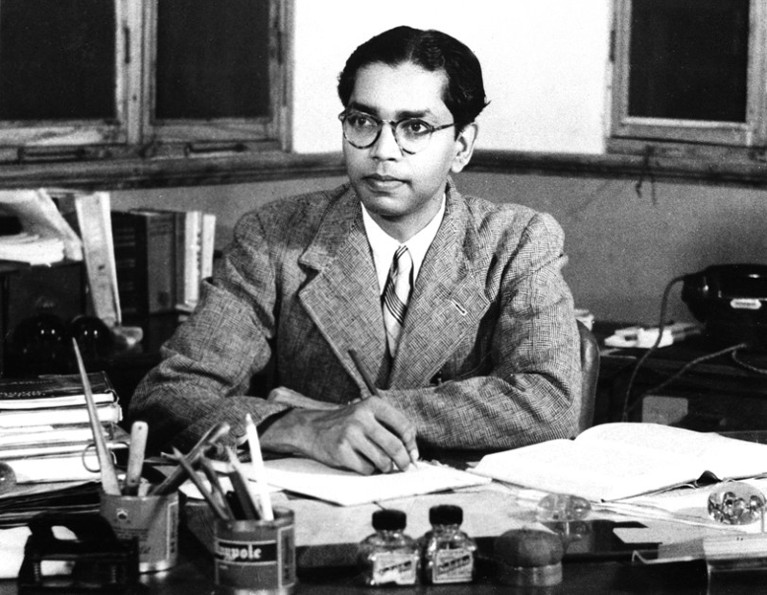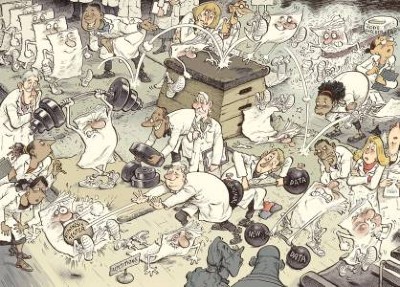
Credit: Tejaswini Rao
Calyampudi Radhakrishna Rao pioneered powerful statistical methods that underpin modern scientific data analyses. His ‘information geometry’ and other data-reduction techniques enable information to be extracted from data sets with many variables, so it can be more easily visualized or classified into groups. Rao, who published seminal papers while he was just in his twenties, has died aged 102.
Rao held that the field of statistics should be driven by applications of it. The building blocks of statistical science that he contributed have had a huge impact in agricultural sciences, biomedical research, econometrics, industrial engineering, social sciences and signal processing. For example, his methods were used to uncover signs of the Higgs boson in data from CERN — Europe’s particle-physics laboratory near Geneva, Switzerland.
Rao was born in Hadagalli, India. His father, a police inspector, had to move frequently for postings until the family settled in Visakhapatnam, India. Both parents noticed Rao’s precocious mathematical ability and encouraged him to do bachelor’s and master’s degrees in mathematics at Andhra University in Visakhapatnam.
Replication games: how to make reproducibility research more systematic
In 1941, Rao joined the Indian Statistical Institute (ISI) in Kolkata, founded and led by eminent statistician P. C. Mahalanobis. The basic principles of statistical inference were still being established when Rao started a master’s course in statistics at the University of Calcutta in what is now Kolkata in the same year. The roots of many data-analysis tools can be traced back to Rao’s master’s and PhD theses, and papers he published in the 1940s. For example, in his master’s thesis (1943), through analysing data from populations living in the Indian state of Uttar Pradesh, he developed the ‘perimeter’ test for comparing two or more experimental groups. This led to the multivariate analysis of variance (MANOVA) procedure for comparing sample means.
In 1943, in response to a student’s question, Rao derived a lower bound (now known as the Cramér–Rao inequality) for estimating unknown parameters of a statistical population, such as the average reduction in people’s blood pressure caused by a new drug. He produced an algorithm (now called the Rao–Blackwell theorem) to derive rules for making such estimations. For example, reductions in blood-pressure measurements in a small random group can provide a good estimate of those of the whole population. Using differential geometry for the first time in statistics literature, Rao also defined a metric for the dissimilarity between two probability distributions (the Fisher–Rao distance). His paper describing these results gave rise to the term information geometry (C. R. Rao Bull. Calcutta Math. Soc. 37, 81–91; 1945).
In 1946, Rao was invited to work at the Museum of Archaeology and Ethnology of the University of Cambridge, UK. He analysed measures of the shapes of skulls excavated from ancient graves dating back several thousand years in Sudan, categorizing the remains according to their tribes and ages. At the same time, he began his PhD studies under the founding father of modern statistics, Ronald Fisher, a friend and collaborator of Mahalanobis. Rao’s work included mapping mouse chromosomes for studies of genetic linkages. His PhD thesis and subsequent papers led to statistical methodologies that provided the foundations of modern data analysis, such as discrimination and classification theories, MANOVA and more.
Fourteen things you need to know about collaborating with data scientists
Rao’s techniques were also applied to the design of experiments and devices, such as computer chips. The goal is to pick key parameters for designing a robust product while minimizing costs, time and labour. These optimal configurations, termed orthogonal arrays, were taken forward by Japanese engineer Genichi Taguchi, and underlie Japan’s revolution in industrial quality since the 1970s.
In 1948, Rao returned to the ISI. He was appointed professor the following year, shortly before his 29th birthday. He had applied for a lectureship at Cambridge too, but despite having published about 30 innovative papers, he was turned down on the grounds that ‘foreigners’ were not usually appointed to teach English students. The ISI, under his leadership, as the head of research and training, and later as director, became one of the world’s premier statistical institutes.
After his mandatory retirement in 1978, Rao moved to the United States. He made a similar impact on statistics programmes at the University of Pittsburgh, Pennsylvania, where he jointly established the Center for Multivariate Analysis. We were fortunate to work on our PhDs with him there. He moved to Pennsylvania State University in State College in 1988 and to the University at Buffalo, New York, in 2010. In 2007, the C. R. Rao Advanced Institute of Mathematics, Statistics and Computer Science, was established in Hyderabad, India.
Of Rao’s many books, his Advanced Statistical Methods in Biometric Research (1952) and Linear Statistical Inference and its Applications (1965) are iconic. Generations of statisticians worldwide were trained using them. Rao received numerous awards: only a few months before his death he became the fourth recipient of the International Prize in Statistics, founded in 2017 to advance understanding of the role of statistics in contemporary life.
Rao enjoyed south Indian classical dances, photography and gardening. He was an exceptional teacher who trained students to think independently, and a humble, soft spoken and gentle person. He will be greatly missed.

 Replication games: how to make reproducibility research more systematic
Replication games: how to make reproducibility research more systematic
 Fourteen things you need to know about collaborating with data scientists
Fourteen things you need to know about collaborating with data scientists
 Charting a course to make maths truly universal
Charting a course to make maths truly universal
 How to hatch, brew and craft the perfect maths partnership
How to hatch, brew and craft the perfect maths partnership
 From better bridges to more efficient cars: how pocket calculators changed the world
From better bridges to more efficient cars: how pocket calculators changed the world
 How to be successful as a research mathematician? Follow your gut
How to be successful as a research mathematician? Follow your gut
 Evelyn Boyd Granville, space-flight trailblazer (1924—2023)
Evelyn Boyd Granville, space-flight trailblazer (1924—2023)






